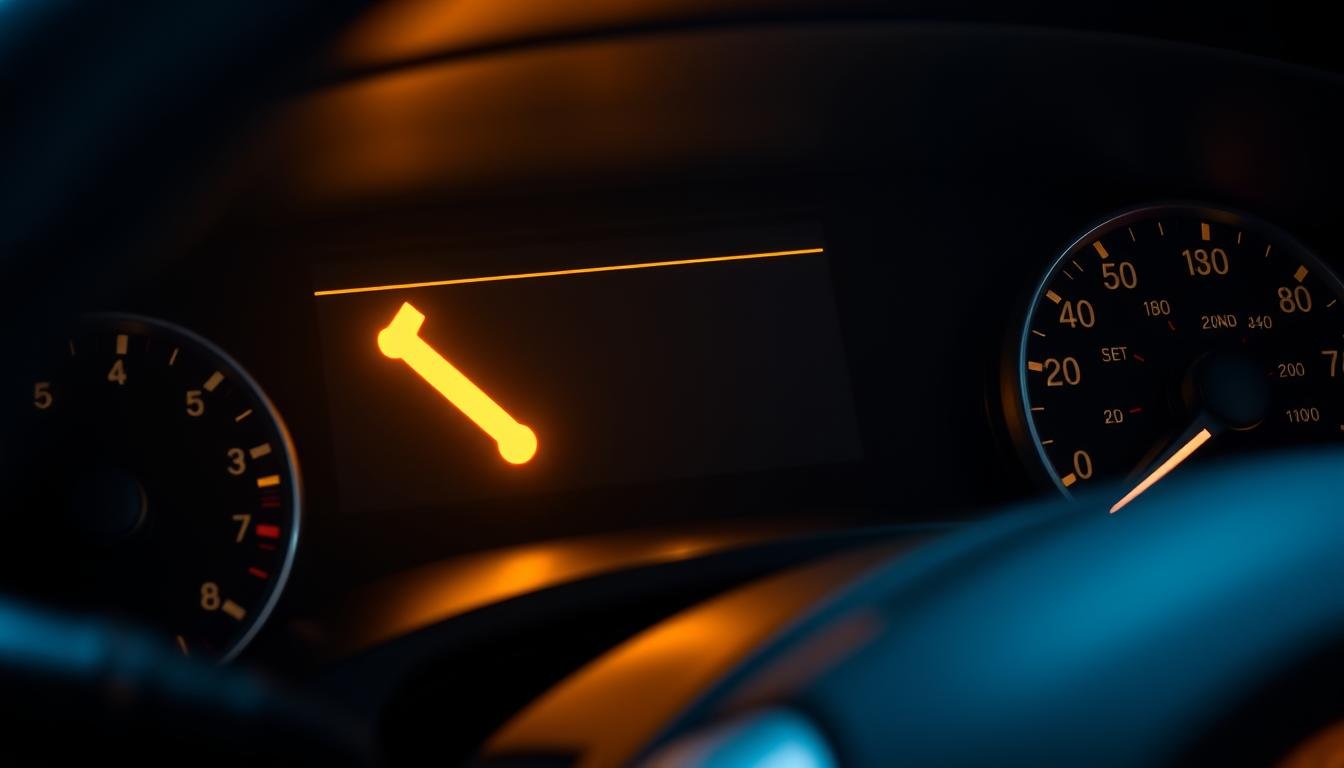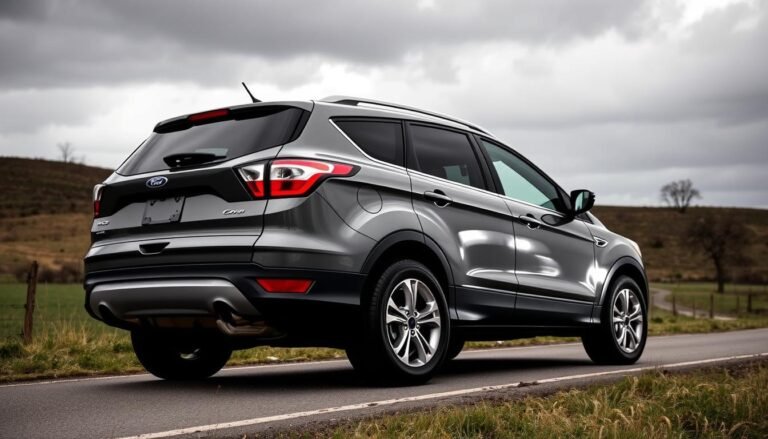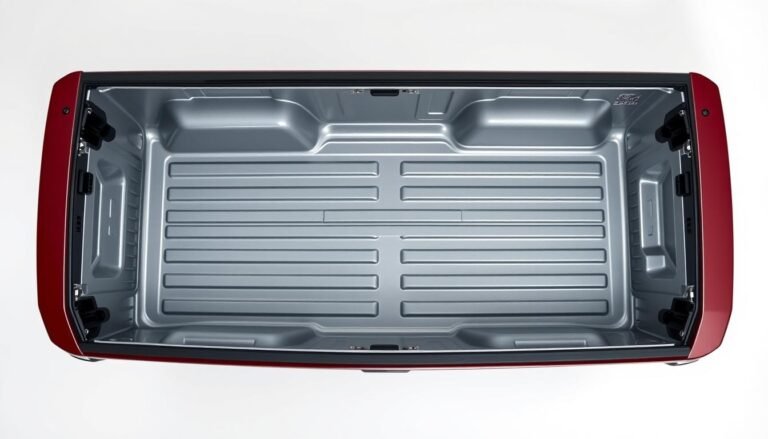What Does A Wrench Light Mean On A Ford? Better 9 Info
The wrench light on a Ford means there might be a problem with your car’s systems. This could be with the throttle control or the transmission.
Knowing what does a wrench light mean on a ford owner. It shows that your car’s computer has found an issue that needs your attention.
This light is different from the check engine light. While the check engine light can mean many things, the wrench light is about bigger issues with your car’s performance and safety.
When the wrench light comes on, you should act fast. First, check your dashboard for other warning lights.
They might give you clues about what’s wrong. If the light is flashing, it’s a sign of a serious problem that needs quick action.
In this guide, you’ll learn how to find out what’s wrong with your Ford. You’ll also learn how to use tools to fix it and keep your car running well.
What is The Ford Wrench Light Symbol
The ford wrench light symbol is key to keeping your vehicle in top shape. It’s a special light for Ford cars, showing problems with the engine, transmission, or throttle.
Spotting this light early is important, as it warns you of issues that could get worse if ignored. Seeing the symbol means you should check what’s wrong right away.
Not taking action can turn small problems into big ones. This could lead to expensive fixes and even safety hazards.
Knowing what the ford wrench light symbol means helps you take care of your car better.
What Does A Wrench Light Mean On A Ford?
The ford wrench light dashboard is a key indicator of your car’s health. When it lights up, it means the onboard computer has found a problem.
This could be with the transmission, throttle body, or other transmission issues. Not paying attention to this light can hurt your car’s performance.
In bad cases, your Ford might go into “limp mode.” This limits power and makes the car less responsive. It’s a safety feature to protect your car’s engine and transmission.
Common Triggers For The Wrench Light Indicator
The ford wrench light meaning often comes from specific mechanical issues. These issues need quick attention.
Knowing what causes the wrench light can help you spot problems early. Here are some common reasons for the wrench light indicator.
Faulty Throttle Body Issues
A bad throttle body can really hurt your car’s speed and engine feel. It controls how much air gets to the engine.
If it fails, your car might not run well. A wrench light could mean your throttle body is the problem.
Transmission Problems
Transmission troubles are big worries that can turn on the wrench light. If your transmission isn’t working right, it can mess up your car’s whole function. You should get it checked fast to avoid expensive fixes.
Failed Sensors
Sensors check how well your engine is doing, like the throttle and transmission. If they fail or give wrong info, the wrench light will turn on. This is a sign of a serious problem that needs fixing.
| Trigger | Description | Impact on Vehicle |
|---|---|---|
| Faulty Throttle Body | A malfunction affects airflow to the engine. | Decreased acceleration and engine response. |
| Transmission Problems | Failures can affect gear shifting and vehicle control. | Potential for severe damage if untreated. |
| Failed Sensors | Incorrect readings related to engine performance. | Can lead to poor engine operation and efficiency. |
Importance of The Wrench Light in Vehicle Diagnostics
The wrench light is key in ford wrench light diagnostics. It warns you of problems that could harm your safety and car’s performance.
Knowing about the wrench light helps avoid expensive fixes. It’s like a warning light that tells you to check things before they get worse.
When the wrench light comes on, it’s time for a check-up. Not doing so can lead to bigger issues or even safety hazards.
Fixing problems early can save you money and time. It’s important to know what your car is trying to tell you to keep it running well.
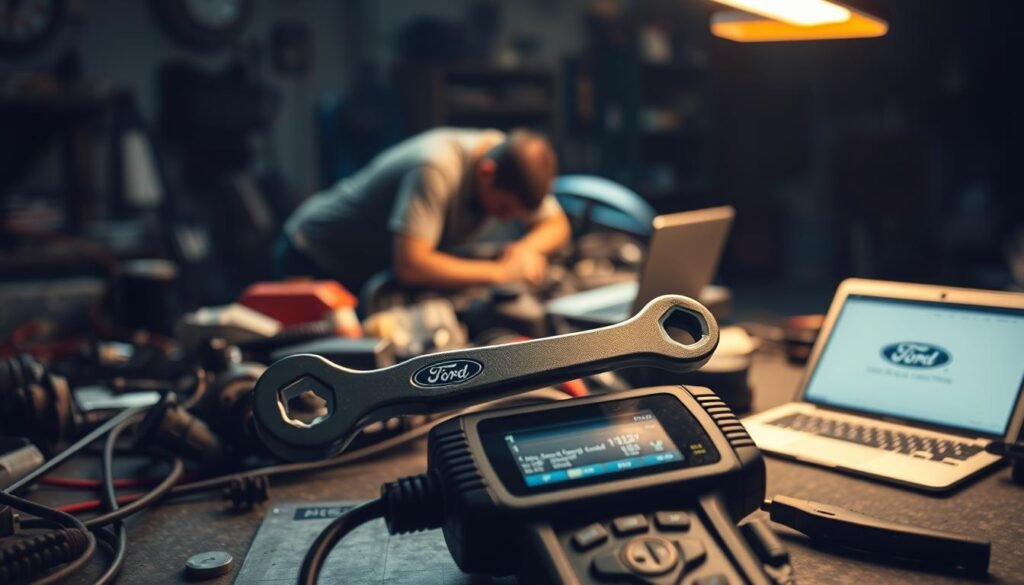
How To Respond When The Ford Wrench Light Comes On
Seeing the Ford wrench light can worry any car owner. It’s key to know how to react when this light turns on.
Start by staying calm and check the dashboard for other warning lights. These can give clues about the problem.
Checking For Accompanying Warning Lights
When the wrench light comes on, first look for other warning lights. These lights can show how serious the issue is.
For example, the check engine or battery warning lights might appear. If you see several lights, it could mean a bigger problem that needs quick action.
Actions To Take If Light is Flashing
If the wrench light flashes, it’s a sign of a serious issue that needs quick action. Pull over safely and turn off the engine.
Driving on while the light flashes can damage your car more. Then, call a skilled mechanic for a proper check-up and fix.
Diagnosing The Issue Behind The Wrench Light
When the wrench light comes on in your Ford, figuring out why needs a certified mechanic’s help.
They start with a detailed check, using special tools to get into the car’s computer. They first look at the diagnostic trouble codes (DTCs) the car sends out.
These codes tell them exactly what’s wrong. Finding the right fix depends on knowing the exact problem, as many issues can cause the same light to come on.
Trying to fix it yourself can lead to wrong guesses and more harm to your car. A mechanic ensures the right diagnosis and fixes the problem quickly and correctly.
| Step | Description |
|---|---|
| 1 | Connect the diagnostic tool to the OBD-II port. |
| 2 | Read and interpret the diagnostic trouble codes. |
| 3 | Perform a physical inspection of possible problem areas. |
| 4 | Test the parts indicated by the codes. |
| 5 | Document findings and talk about repair options with the owner. |

The Role of Diagnostic Tools in Resolving Wrench Light Issues
Diagnostic tools are key for fixing wrench light problems in vehicles. When the wrench light comes on, using the right tools helps find the cause.
This involves connecting to the OBD-II system and reading the Diagnostic Trouble Codes (DTCs). This methodical approach helps solve the issues effectively.
Connecting To The OBD-II System
Mechanics connect the diagnostic tool to the OBD-II port. This lets them check the codes from the vehicle’s computer. It’s the first step in figuring out what’s wrong with your car.
Reading Diagnostic Trouble Codes (DTCs)
After connecting, the next step is to read the Diagnostic Trouble Codes (DTCs). These codes show the specific problems with your Ford.
Each code points to a different issue, making repairs more focused. Using the right tools helps in a structured way to fix and prevent future problems.
Common Repairs Related To The Wrench Light
The wrench light often means there’s a problem that needs fixing. It’s important to tackle these issues to get your car running right again.
You might need to replace parts and reset the wrench light after repairs.
Replacing Faulty Components
Fixing the problem might involve different parts. Here are some key areas to check:
- Defective throttle body
- Malfunctioning sensors
- Wiring harness connected to the throttle and transmission systems
Resetting The Wrench Light After Repairs
After fixing the issue, you need to clear any error codes from the car’s computer. This step is key for a successful wrench light reset.
It makes sure the problem is solved and your car works as it should.
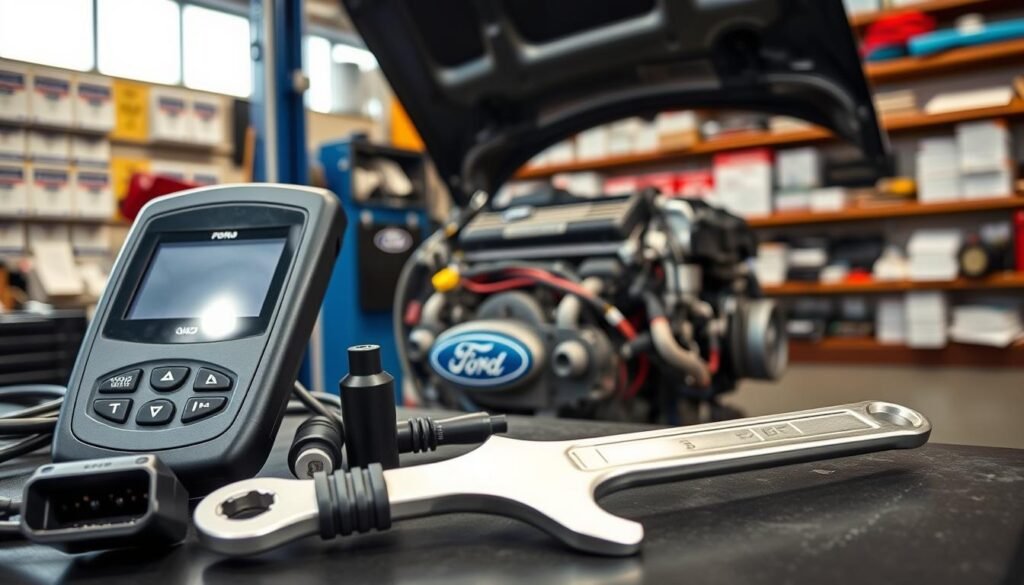
Preventive Measures To Avoid Wrench Light Activation
Knowing how to stop the wrench light from turning on is key to keeping your car running well.
Taking steps to prevent issues can make your car more reliable and save you from costly repairs. Make sure to do regular maintenance, including:
- Routine oil changes to keep the engine running smoothly.
- Regular replacement of the air filter to ensure proper airflow.
- Prompt service for check engine lights and other alerts to address issues early.
- Maintenance of electrical systems and connections to prevent malfunctions.
By following these steps, you can avoid the wrench light and save money on repairs. Being proactive ensures a safer and more reliable drive.
| Maintenance Task | Frequency | Importance |
|---|---|---|
| Oil Change | Every 5,000 miles | Ensures engine lubrication and longevity. |
| Air Filter Replacement | Every 15,000 miles or as needed | Promotes engine efficiency and horsepower. |
| Check Engine Light Assessment | As soon as it activates | Prevents escalation of minor issues. |
| Electrical System Inspection | Every 30,000 miles | Avoids unexpected breakdowns and ensures proper function. |
The Difference Between The Wrench Light and Check Engine Light
Knowing the difference between the wrench light and check engine light is key for car owners.
Both lights on your dashboard warn of problems, but they mean different things. The wrench light usually means there’s a powertrain issue.
This includes troubles with the transmission or throttle control. These issues can affect how well your car runs and drives.
The check engine light, on the other hand, points to engine problems. These can mess with emissions and how well the engine works.
While the check engine light can signal many issues, the wrench light focuses on key powertrain parts. Not paying attention to these lights can cause big problems with your car.
It’s important to know what each light means. This way, you can fix the right issue and keep your car running smoothly.
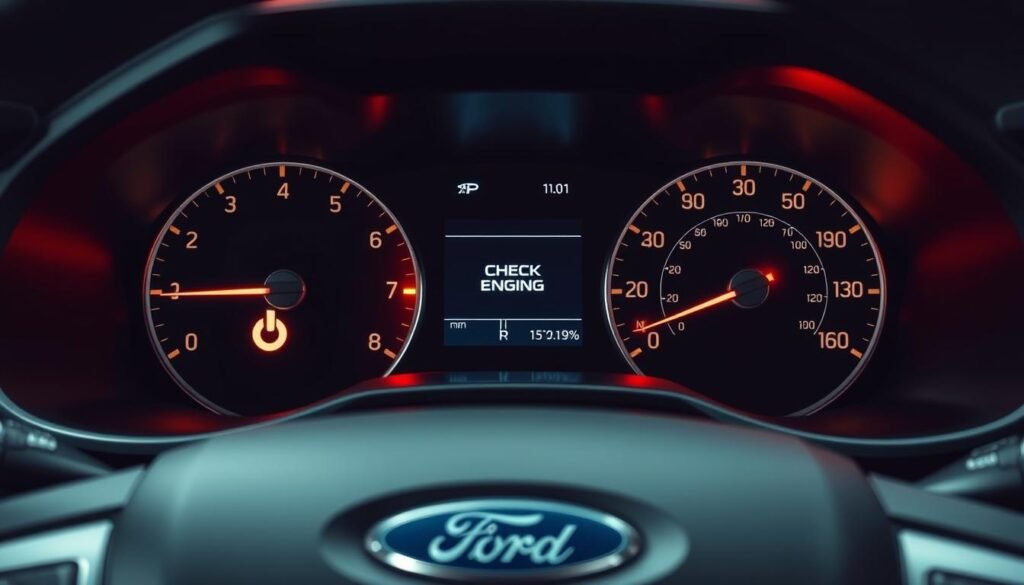
Potential Safety Risks of Ignoring The Wrench Light
Ignoring the wrench light on your Ford can lead to serious safety risks. This warning shows that something might be wrong with your vehicle’s performance and safety.
If you ignore it, your car might go into “limp mode.” In “limp mode,” your engine power drops a lot. This makes it hard to drive safely. It’s a big problem.
Not fixing the wrench light can lead to more problems. It can make driving dangerous and increase repair costs. It also means you and your passengers could face risks on the road.
By ignoring the wrench light, you risk losing control of your vehicle. It’s important to address these warnings to keep everyone safe.
Conclusion
The wrench light on your Ford is a warning you can’t ignore. It’s a sign of trouble that needs your quick attention.
Knowing what it means and how to fix it can keep your car safe and running well. Fixing the wrench light right away helps avoid bigger problems later.
If you ignore it, your car could have serious issues. Regular check-ups after the light comes on are essential to keep your Ford in top shape.
By taking these warnings seriously and acting fast, you keep your Ford running smoothly. This also keeps you and others safe on the road.
Knowing what your car needs is key to being a good owner and keeping it running for a long time.
FAQs
Q: What does a wrench light mean on a Ford?
A: The wrench light means there’s a problem with the powertrain. This could be with the throttle or the transmission. You need to check it right away to keep your car safe.
Q: How serious is the Ford wrench light warning?
A: The wrench light is a serious warning. It means there could be issues with your car’s safety and how well it runs. If you ignore it, you might face big problems, like your car going into “limp mode.”
Q: Can I continue driving if the wrench light is on?
A: If the wrench light is steady, you can keep driving but don’t speed up too much. But if it’s flashing, stop right away and get help.
Q: How can I reset the Ford wrench light after repairs?
A: After fixing the problem, you need to clear the trouble codes from your car’s computer. This will turn off the wrench light and show that the fix worked.
Q: What are common triggers for the wrench light to activate?
A: The wrench light often turns on because of problems with the throttle body, issues with the transmission, or if sensors for the throttle and transmission fail.
Q: What should I do when the wrench light comes on?
A: Stay calm and look at the dashboard for other lights. If you see the wrench light, don’t drive too fast and get it checked by a mechanic as soon as you can.
Q: Difference between the Ford wrench light and check engine light?
A: The wrench light is for powertrain problems. The check engine light is for engine issues and emissions.
Q: How can I prevent the wrench light from activating?
A: Keep your car in good shape with regular oil changes, air filter swaps, and checking warning lights on time. This can help avoid the wrench light.

